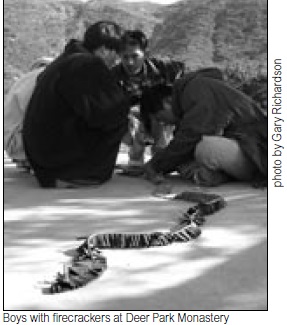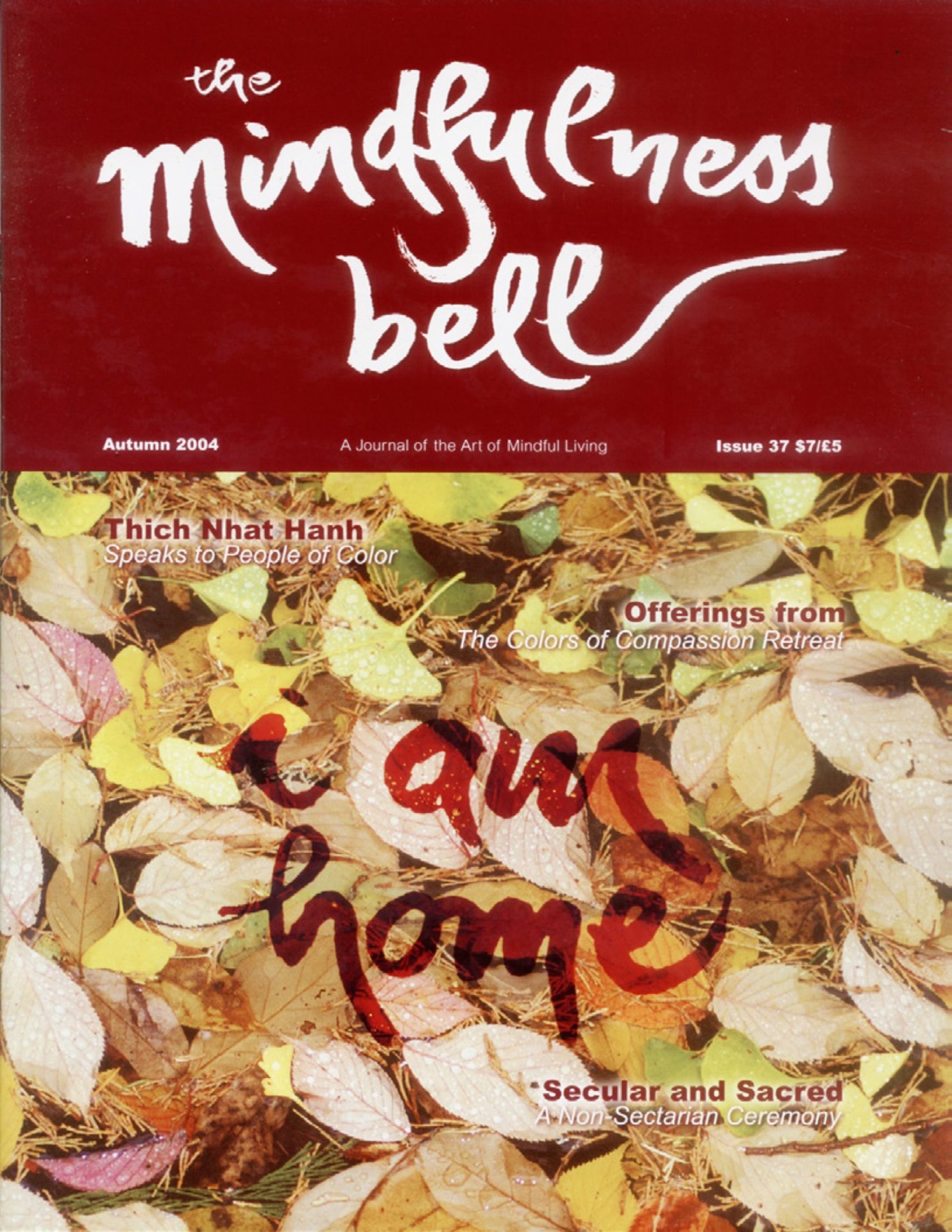
by Terry Miller
I spent two weeks of the 2004 Winter Retreat at Deer Park Monastery as part of my personal and professional work, during a sabbatical from my college teaching job. I have been researching, contemplating, and writing about boys and violence. This topic is very much a part of my own personal practice, as I confront my maleness and the violence of my country.
Growing up as an American boy,

by Terry Miller
I spent two weeks of the 2004 Winter Retreat at Deer Park Monastery as part of my personal and professional work, during a sabbatical from my college teaching job. I have been researching, contemplating, and writing about boys and violence. This topic is very much a part of my own personal practice, as I confront my maleness and the violence of my country.
Growing up as an American boy, I felt alienated from most of my American brothers, and extremely sensitive to the violence in the culture of boys. I turned eighteen in 1967 and was drafted into the army to fight in the war in Vietnam. I refused to serve and helped others to resist the war. As luck would have it, I did not have to fight or kill in a war that I did not support, nor did I have to serve time in prison, as I had expected.
I became an elementary school teacher, and thus continued to spend my days with boys and girls. I tried to integrate peace education and conflict resolution into my classroom, and I worked with other teachers and parents in this effort. Deep down, I still felt alienated from men and boys. I was repulsed by violence on the playground, in sports, in the media, and especially by the cruel physical and verbal bullying which seemed so common in the culture of boys.
In the early 1990s, and again in 2003, many Americans were in full support of the U.S. participation in the wars in the Middle East, believing that bombing and killing were necessary to maintain our safety. At the same time, from the 1990s on, the violence in the culture of boys took a terrible turn. Horrific incidents of shootings in schools began, and awareness grew of the prevalence of physical and verbal bullying among teens. Many of us felt increasing revulsion and despair at the violence of men and boys. We asked ourselves: What is wrong with this entire gender of human beings?
As Thich Nhat Hanh teaches, we are not separate from those boys and men. They are me, and I am the product of the same cultural experience. It was time for me to look deeply at the behavior of boys and at my own behavior. My time in Deer Park was a crucial part of that work.
So many of the stories I have read, both factual and fictional, confirm that beneath the inclination to violence lies deeply rooted fear. We fear the enemy; we fear violence and death caused by bad people or bad nations. Boys and men are raised with another, equally powerful fear—the fear of weakness, the fear of cowardice, the fear of being shamed.
Sports, “play fighting,” violent entertainment, and bullying are integral parts of this culture today—all serving as tests of a boy’s manliness. The largely unspoken, deeply disturbing truth is that we, the adult men and women of America as well as many other societies, feel that we need our boys to be ready to fight our enemies. When we ask why our boys become so violent and cruel, perhaps it is because we think we need them to be this way.
When we look at ourselves deeply, we confront our deepest fears. To look at violence in others, we must see the seeds of violence in ourselves. We must see that our children are acting out our fears, and that we and our enemies are interconnected. Only then can we begin to help our boys and girls find a better way to be.
We need to plant and nourish seeds of nonviolence and compassion in our boys and girls. Men and women need to model how to face our fears in a peaceful way. We need to show our children how to be empathetic to all beings ––how to see ourselves in other beings, even in the perceived enemy. We need to talk about our own mindfulness trainings practice, and demonstrate how we attempt to put peace and compassion into practice, moment to moment.
One concrete way to facilitate discussion of this topic is to read aloud novels with a peacemaking theme, and to discuss the feelings and actions of the characters with our children. Boys and girls can learn from the modeling of peaceful heroes in children’s literature, and the discussion of alternative responses to conflict situations is a concrete way to nurture peaceful behavior in us all.
For example, the hero of Kathe Koja’s novel, Buddha Boy, is tormented constantly by some of the football players in his high school because of his shaved head and Buddhist practices. His friends urge him to get even –– the traditional response to bullying. He refuses to do this, saying: “...if I tried to get even, I’d be worse than he is, I’d be more wrong than he is. Because he doesn’t know. But I do.” “Know what?” “That we’re all gods,” he said, “gods inside, all of us. Him too.”
Crash, by Jerry Spinelli, has two differing role models for how to be a boy. One is Crash, the football player who loves physical sports and the thrill of competition, and who uses some of his aggressiveness to torment his neighbor, Webb. Webb is a peace-loving boy, who has the courage to be different. It is Crash’s concern for his beloved grandfather after he suffers a stroke, which begins his “softening” and the development of his natural empathy. He begins to appreciate the strength and courage of Webb’s way of being a boy.
In the novel, Charlie Pippin, by Candace Dawson Boyd, the heroine, Charlie, becomes curious about her father’s experience in the Vietnam War, which he refuses to talk about. As part of a research project for school, Charlie attends peace rallies, reads books about the war, talks to veterans, and finally, visits the Vietnam War Memorial Wall in Washington, D.C. When she brings back rubbings from the Memorial with the names of two men who fought with her father and died in the war, her father is finally able to share his extreme grief and bitterness about the war.
In using these books for reading and discussion, some children immediately identify with the peacemaking heroes and heroines in these books. Others disagree with the actions of the characters, but still can consider and discuss the effectiveness of using nonviolent alternatives in these situations.
It is not enough to simply tell our children not to kill or act violently, and not to play at violence. We have to show them ways of being strong, brave, and heroic without hurting others. We have to offer them stories of peaceful and creative alternatives to violence. Most important, we have to be models of mindfulness, living our teachings in our daily relationships.
Terry Miller is a professor of education at St. Cloud State University. A member of the Compassionate Ocean Dharma Center Sangha in Minneapolis, Minnesota, his Dharma name is Lamp of True Joy in the Japanese Soto Zen tradition.

